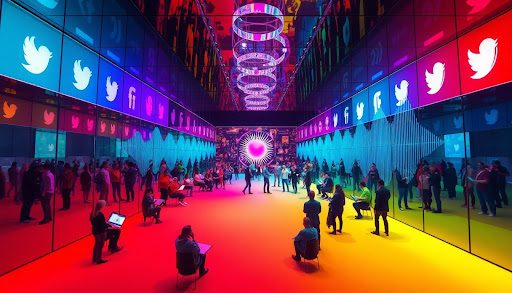Political polarization examples
In the United States, the gap between political sides has grown wider. This gap, known as political polarization, affects how we vote and talk about issues. It has changed how laws are made and how we discuss public matters.
Political polarization shows up in many ways. It changes how people vote and how laws are passed. It also shapes public debates. Knowing about this issue is key because it shows how our political climate is doing. It also affects our democracy’s future.
Key Takeaways
- The partisan divide in the United States has become increasingly pronounced in recent years.
- Ideological differences between political factions are driving a growing social and cultural split, a phenomenon known as political polarization.
- The effects of political polarization are visible across various aspects of American society, including voting patterns, legislative processes, and public discourse.
- Understanding the complex issue of political polarization is crucial for the future of the country’s democratic processes.
- The article will explore the historical context, key factors, and real-world examples of political polarization in modern America.
Understanding Political Polarization in the United States
In today’s America, the gap between political parties is huge. This is called political polarization. It shows how far apart people’s beliefs and partisan conflict have grown.
Defining Modern Political Division
Political polarization means people’s beliefs are more extreme. This creates a big gap between party alignment and political tribalism. It has made politics more rigid and confrontational.
Historical Context of American Political Divide
The divide in America started at its founding. Different visions for the country’s future and government roles caused it. But today’s ideological gap is much bigger, thanks to social, economic, and demographic changes.
Key Factors Driving Polarization
- Economic inequality and the widening wealth gap have fueled resentment and distrust towards the political establishment.
- Demographic shifts, such as increasing racial and ethnic diversity, have challenged traditional notions of identity and belonging, leading to the rise of identity politics.
- The proliferation of social media and the fragmentation of the media landscape have exacerbated the creation of ideological echo chambers, reinforcing the divide.
These factors are shaping our politics. Bridging the divide and starting meaningful talks is key for America’s democracy.
“The greatest challenge our country faces is the increasing polarization of our politics. It’s not just a disagreement over policies, it’s a fundamental difference in how we view the role of government and our place in society.”
| Factors Driving Polarization | Impact on Political Divide |
| Economic Inequality | Fuels resentment and distrust toward the political establishment |
| Demographic Shifts | Challenges traditional notions of identity and belonging, leading to the rise of identity politics |
| Media Fragmentation | Exacerbates the creation of ideological echo chambers, reinforcing the divide |
Social Media’s Role in Amplifying Political Division
In today’s world, social media plays a big role in how we talk about politics. The rise of echo chambers and filter bubbles on these sites has made political divisions worse in the United States.
Algorithms on social media often show us content that matches what we already believe. This creates online spaces where different views are ignored. It’s hard for people to talk across party lines in these environments.
Also, viral misinformation spreads fast on social media, making things worse. False and emotional content can quickly become popular. This shapes how people see things and makes divisions deeper.
“Social media has become a breeding ground for political extremism, where echo chambers and filter bubbles enable the rapid spread of divisive rhetoric and false information.”
The effect of social media on political divisions is deep and complex. As these platforms change, it’s key for everyone to work on fixing these issues. We need to make sure online political discourse stays informed, fair, and helpful.
Political Polarization Examples in Contemporary Politics
The political divide in the United States is growing. It’s changing how we vote, how laws are made, and how we talk about politics. The effects of partisan voting and sorting by ideology are clear.
Voting Pattern Changes
One big change is the rise of straight-ticket voting. People are voting for candidates based on their party, not their qualifications. This makes it harder for people from different parties to work together.
Legislative Gridlock Cases
Politics has become more partisan, leading to more gridlock in Congress. Lawmakers often put party loyalty before solving problems. This makes it hard to pass important laws, frustrating many people.
Public Discourse Transformation
Political talk has also changed. It’s now more extreme, with harsh words and personal attacks common. This makes it tough to have respectful discussions and find common ground.
These examples show we need to work on being more bipartisan. We must think critically and try to find ways to bridge the gap. Only then can we create a more united and effective political system.
Cultural and Geographic Divides in American Society
The United States has long faced the urban-rural divide and its effects on politics. As demographic shifts change the country, this gap has grown. It has led to more cultural polarization across regions.
Urban and rural communities have different values and lifestyles. Urban areas often support progressive views on gun rights, abortion, and immigration. Rural areas tend to be more conservative on these topics. This difference has widened the regional differences in politics and voting.
The urban-rural divide shows more than just geography. It reflects social and economic trends. Urban areas are centers of innovation, education, and jobs. This contrasts with rural areas, which struggle more. This gap has caused resentment and a feeling of being left out among rural people, making cultural polarization worse.
| Urban Areas | Rural Areas |
| Tend to embrace progressive ideals on issues like gun rights, abortion, and immigration. | Often hold more conservative views on these matters. |
| Hubs of innovation, education, and economic opportunity. | Struggling communities, leading to a sense of resentment and disenfranchisement. |
| Increasingly diverse and cosmopolitan populations. | Homogeneous communities, with a focus on traditional values and way of life. |
As demographic shifts and regional differences shape politics, it’s key to bridge the gap. Policymakers and leaders must work to make society more inclusive. By tackling the causes of polarization, we can overcome the cultural and geographic divides in America.
“The division between urban and rural areas is not just geographic, but a reflection of deeper social, economic, and cultural differences that have become increasingly entrenched in American politics.”
Media Echo Chambers and Information Bubbles
In today’s world, cable news and online news have made politics more divided. These media echo chambers show us only what we want to see. This makes us stick to our beliefs and miss out on different views.
Cable News Polarization
Cable news networks aim for high ratings, so they often lean one way politically. This means we see news that fits our views, not others. It makes us less open to new ideas and deepens our political gaps.
Online News Consumption Patterns
The internet has changed how we get our news. Social media and algorithms let us pick what we see. This creates “information silos” where we only see what we agree with, making our views stronger but less diverse.
Fact-Checking Challenges
With so much bias and selective news, checking facts is hard. Misinformation spreads fast, making it hard to know what’s real. This erodes trust in media and widens our political gaps, as we struggle to find reliable information.
FAQ
What is political polarization and why is it important to understand in modern America?
Political polarization means people are more divided by their beliefs and party affiliations. It’s crucial to grasp this in today’s America. It affects how we vote, what news we watch, and how we talk to each other. It also impacts how well our society sticks together.
What are the key factors driving political polarization in the United States?
Several things are making the US more divided. These include big economic gaps, changes in who lives where, the rise of focusing on identity, and how social media shapes our views.
How has social media contributed to amplifying political division?
Social media has made political divisions worse. It creates spaces where people only hear what they agree with, spreads false information, and shows content that supports one side over the other.
Can you provide examples of political polarization in contemporary American politics?
Sure. We see it in how people vote, with more voting for one party all the way down the ticket. Congress is often stuck, unable to pass laws. And public talks have become more extreme, with less agreement between parties.
How have cultural and geographic divides contributed to political polarization in the United States?
The divide between cities and rural areas, and disagreements over cultural issues like guns, abortion, and immigration, have made the country more divided. These issues affect different parts of the country differently.
What role has the media played in perpetuating political polarization?
The media, especially cable news and online news, has played a big part in making us more divided. It creates spaces where people only see what they agree with, makes it hard to verify facts, and spreads false information.






